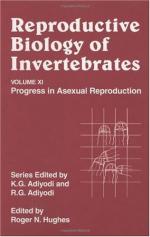|
This section contains 759 words (approx. 3 pages at 300 words per page) |

|
Asexual reproduction is a method of reproduction that does not involve meiosis or the union of gametes. As a result, the segregation and recombination of genetic material that are a normal part of sexual reproduction do not occur, and offspring are genetically identical or nearly identical with the parent organism. In normal sexual reproduction, offspring are genetically different from either of the parents, and as a result new traits may be introduced into the population. Some members of this diverse population may be able to adapt to changing conditions in ways that the parents could not, and the species as a whole is advantaged. In asexual reproduction these advantages are lost, but under some conditions the opportunity for rapid increase in numbers of individuals may compensate for this disadvantage.
Asexual reproduction is found in many types of organisms including bacteria, algae, fungi, plants, and some simple...
|
This section contains 759 words (approx. 3 pages at 300 words per page) |

|


